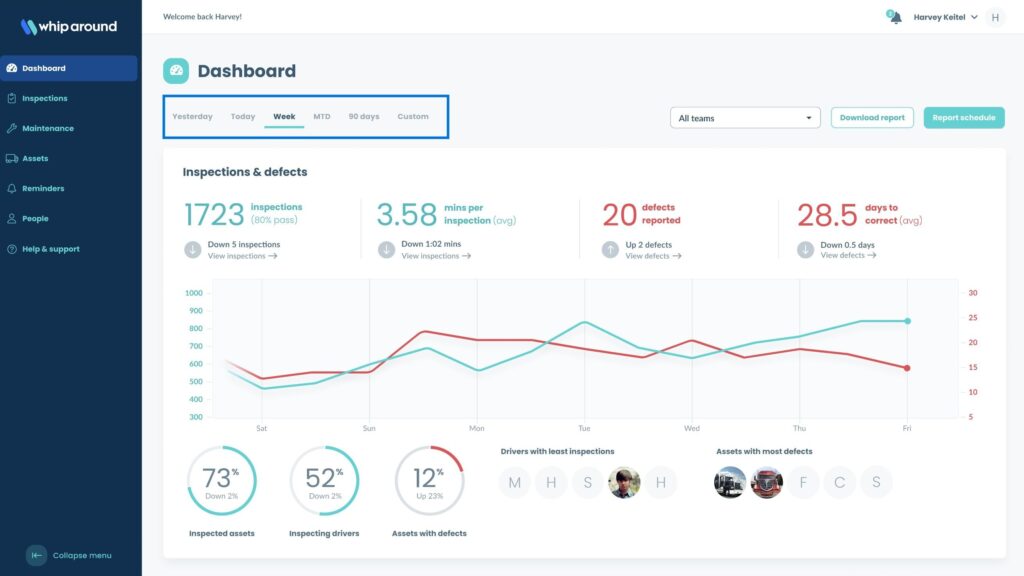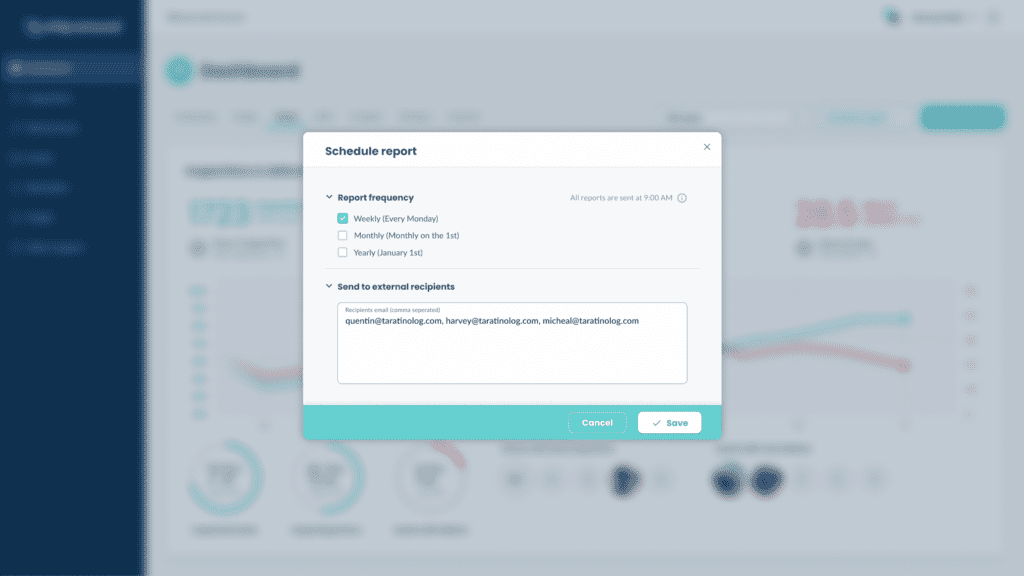As fleets transition toward using more digital tools, they gain access to more and more information. And while this info typically meets immediate needs (like alerting you when a vehicle is due for a service), it can often be used in ways that enable you to discover trends, patterns, and insights which can help your decision making down the road. Data-driven fleet management is about using the data you collect to make the best possible decisions for your fleet.
This article will examine what it looks like for a fleet to get the most out of their data. We’ll do so by examining some of the data available to Whip Around users, but these concepts will also apply to many of the other digital tools you’re using.
The value of data-driven fleet management
We’d like to think that all of our business decisions are based on empirical data and sound reasoning. But even when we think we’re objective, we often make assumptions based on perceptions, biases, and emotions.
With good data, however, you can make decisions backed up with hard, empirical facts. And you don’t have to go out of your way to find usable data. Quite often, it’s a matter of putting the data you’re already collecting to new uses.
Fleet managers can use data to support decisions like:
- What kinds and makes of assets to purchase
- When it’s time to unload an asset
- How to optimize maintenance
- What kind of driver training would be most helpful
You might be surprised at the ways the data you’re already collecting can inform these decisions.
How to think about the data you’re collecting
The most critical step toward data-driven fleet management begins when you start looking at the data you’re capturing through a big-picture lens. Looking beyond the immediate utility of data can enable us to discover new interpretations and uses of our data, but this requires embracing the advantages of information and prioritizing its use.
Moving toward data-driven fleet management takes both intelligently collecting data and using it to inform decisions.
Put data to short- and long-term use
The expectations of fleet managers can be different from one company to another, but for the most part, they share many of the same responsibilities. Fleet managers purchase and maintain vehicles and assets, register and license them, train drivers, uphold safety standards, manage costs, and maximize profit.
You’re likely already collecting data that can inform these areas. Looking at the information you’re gathering through the lens of your various responsibilities is key. When you do that, you begin seeing how data can help you achieve new goals.
For instance, many organizations invest in Whip Around to improve and simplify the inspection process. It allows drivers to perform DOT-compliant inspections with their mobile device and instantly alert fleet managers when defects are found, so work orders can be created, and the vehicle can get into the repair pipeline quickly.
So this data is doing important work in immediate and obvious ways. But when you think about all the data Whip Around collects from a broader perspective, you discover ways it can inform critical decisions.

These digital inspections aren’t sheets of paper stored in file cabinets or entered on various spreadsheets. They generate data that’s accessible through the app’s dashboard, offering an in-depth view of inspections, defects, and repairs over time. With this view, fleet managers can make better-informed decisions or provide clear requests and recommendations to leadership while having the requisite data to back up their plans.
For instance, over time, Whip Around gathers data that can help inform important questions like:
- Which defects show up in specific manufacturer makes?
- Are there environmental issues along specific routes impacting our vehicles?
- Are there problems showing up regularly with specific drivers that might demonstrate bad driving habits?
- How are we trending overall in repair turnaround times?
- Are there repair shops that offer faster turnaround times or require fewer return visits?
- How are we trending in part costs and stocking?
Using immediate, long-term, and aggregate data
Data can be useful in various ways. You can monitor data to make quick decisions about critical issues, compile it to make long-term decisions about priorities and spending, or pull data from multiple sources and reports to develop a more complex understanding of your business and its processes.
- Immediate, actionable data
This is the data you can act on immediately. If a daily inspection comes back with a defect, you need to act on that pretty quickly. Most companies invest in specific digital tools intending to get reliable information quickly so they can improve on a particular process. You can think of this as the data-driven level one.
A company like Avanti Window is a good example of a data-driven team using Whip Around data to keep their fleets compliant and stay on top of repairs and preventive maintenance. Across their two plants and ten hubs, managers focus on the Whip Around dashboard, ensuring they stay up to date on new defects, existing work orders, and scheduled maintenance notifications. This data empowers them to act immediately to meet their goals, stay on top of preventative maintenance, and remain free from accidents and compliance-related fines.
Another example is Ernst Concrete, which relies on Whip Around to stay on top of preventative maintenance and outstanding work orders.
These organizations are using data to know when an issue must be addressed so things don’t fall through the cracks.
- Long-term data
Over time, the same data you have relied on to make immediate decisions can offer invaluable insights, allowing you to zoom out and recognize trends and problems that you might not be able to catch by focusing on data as it comes in. When you start using your data to spot persisting trends and issues, you’re better equipped to make informed, data-driven decisions.
We see this in companies using Whip Around, like Mazza Recycling. Their drivers receive daily notifications at 8 AM and again at 6 PM, reminding them to complete their pre/post-trip inspections. Over time, they can recognize drivers who struggle to stay on top of inspections, neglecting to start or finish them. They also use Whip Around to monitor the costs associated with different divisions, tracking costs over months, quarters, and years.
- Aggregate data
As you gather data over time for different purposes (and from various sources), you can consolidate that data in different ways to offer you a more cohesive view into areas of responsibility. Compiling long-term data from various reports and across various sources offers insights you may not have considered.
For example, say we wanted to build a report about The Waste Industry’s Most Common Maintenance Issues. To create this report, we would be able to query Whip Around data for multiple waste management companies and come up with some interesting insights about waste-management fleets.
The report could explore:
- The most common makes of various waste-management vehicles
- The most common maintenance issues by part
- The average time it took to resolve those issues
Over time, a company could aggregate their Whip Around data from inspections to repairs to offer deeper discernment into operations. Not only can they know which specific vehicles are giving them the most problems, but maybe also isolate problems in specific makes or with specific routes or drivers.
They can watch maintenance trends over time to ensure they’re improving their maintenance times and processes, but—depending on how they collect and organize their data—they can also recognize which internal mechanics or external shops offer the quickest turnaround.
Set yourself up to collect useful data
When you rely on digital tools to gather data and make decisions, you get better at discerning the kinds of data that would be helpful in the future. As you get better at identifying the data you need, you’ll improve your ability to collect it.
A good example of this can be seen in the way various companies use Whip Around’s inspection forms. If an organization is simply thinking about simplifying the daily inspection process, they might create a pass/fail field on their inspection form for “lights” that is intended to cover all the truck’s external lights. When there’s a problem, the driver checks the “fail” box and leaves a note about which light is out.
While simpler in the short term, it limits the kind of data they have available later. If they want to pull a report that shows which lights tend to go out most frequently and get a better handle on which parts they should keep on hand, they might create an inspection report with fields for headlights, turn signals, front side-marker lights, etc.
The challenge lies in balancing short-term needs against gathering potentially helpful data. You want easily accessible and informative data but don’t want your drivers working from an inspection report with 500 fields. The more time you invest in the data available, the better you’ll get at setting yourself up to capture the right data in the future.
Make data-based decisions
The technological revolution has simplified many tasks, but one of the greatest benefits has been the depth of new information. Humanity generates more than 2.5 quintillion bytes of data every day. And this kind of info offers a clarity and granularity that’s never been available before. Decisions don’t have to be made based on limited information and instinct.
The breadth of information available through the digital tools available to your business can inform how you make decisions and validate future strategies.
Data-driven decision making can help you:
1. Become more confident in your decisions
The more you lean on data for decision making, the more confident you become about your decisions. Data helps to set a benchmark for the current state of your business, taking the guesswork out of assessing operations and performance.
You’ll be better prepared for things like:
- Establishing a preventive maintenance program that works
- Unloading assets before they become liabilities
- Crafting effective driver training programs
- Improving your maintenance processes
2. Save your business money
Ultimately, data-driven decision making improves your operational efficiency, which almost always leads to lower costs. As your processes improve, so does productivity. The money you spend goes further, and you have a clearer picture of where cuts can be made.
3. Create a more proactive fleet
When you first start digging into the data, you will feel much more reactive. You’ll see problems and opportunities you didn’t recognize and want to jump on those immediately. Over time, however, you’ll be able to recognize trends and opportunities before they become urgent and problems before they become serious.
Tips for becoming more data driven
You already have digital tools collecting information, and you’ll likely have more in the future. So how do you transition toward becoming a more data-driven fleet manager? It’s about making decisions differently and looking at data in new ways, and part of that requires developing new skills.
The expectation of acquiring new skills and tools can feel overwhelming, but plenty of online tools can make the process much easier. It’s critical to remember that data gathering isn’t just a trend; it’s an inevitability for every industry. Going forward, every management position will require a deftness at handling and interpreting data.
Learning to be more data driven will give you a leg up as a fleet manager today, but soon it will be a base-level requirement for anyone interested in managing company assets. Here are some tips for improving your ability to incorporate data in your role as a fleet manager.
Go to the data first when making decisions
A lot of managers are used to making decisions based on instinct and experience. In fact, for the longest time, good managers were known for their gut-level decision making. Today, the best management decisions are based on thoughtful analysis of the data available.
When you have to make a decision, consider the data at hand. If you don’t have valuable data, this is where you can come up with creative ways to look at your existing data or collect new data that can help inform decisions. The more often you go to the data when drawing conclusions, the more naturally you’ll rely on careful analysis when critical decisions need to be made—and the better you get at knowing what kind of data you want to collect in the future.
Start watching for patterns and correlations
At its heart, becoming a more data-driven manager requires looking beyond the obvious. As you become more analytical, you’ll begin recognizing correlations between data points and see patterns develop. You draw new insights from these correlations and patterns that will inform new conclusions and future decisions.
You can jumpstart your ability to recognize these patterns by taking online analytics courses. You can also take advantage of some online resources for mock data, where you can develop your skills at drawing conclusions from datasets.
But, over time, the more you pay attention to your data, the more you’ll recognize emerging patterns.
Learn to visualize data
People who spend their whole lives analyzing data will affirm that it’s incredibly challenging to extract all the meaning available from a spreadsheet full of raw figures. That’s why you’re used to seeing data presented in graphs and charts. Data visualization is the representation of information that makes it more accessible and understandable.
Start by paying attention to the ways that information is presented to you. We’re pretty used to passively taking in data without thinking about the choices that went into how it’s represented. If you see a bar graph, line graph, or Mekko chart, consider the raw data being represented that way. Ask yourself why someone would choose to represent the information this way and not in another.
If you’re unsure where to start, you can use several data visualization techniques and tools to better understand how to visualize data. As you get a handle on data visualization, you’ll be better equipped to extract (and share) critical data insights.
Monitoring data-driven decisions
While data-driven management can offer better outcomes than operating on pure instinct, it’s not always trouble free. It’s possible to collect bad data or interpret data poorly. The outcomes can be problematic when we draw conclusions and choose actions based on bad data.
This is why we must monitor and measure every business decision to ensure we’re on the right track. If outcomes are not following projections, we may need to go back and readdress the data. If things go as planned, measuring has given you more usable data for the future.
Improve fleet data with Whip Around

With Whip Around, you have the immediate benefit of simpler, DOT-compliant inspections, improved repair turnarounds, preventative maintenance schedules, and visibility over your fleet. And through the intuitive fleet manager dashboard, you can access data that only gets more valuable over time. You’ll better understand your assets and teams and be prepared to spot trends and make decisions that will improve productivity, lower costs, and improve morale.
Schedule a free demo to see what Whip Around data can do for you.









